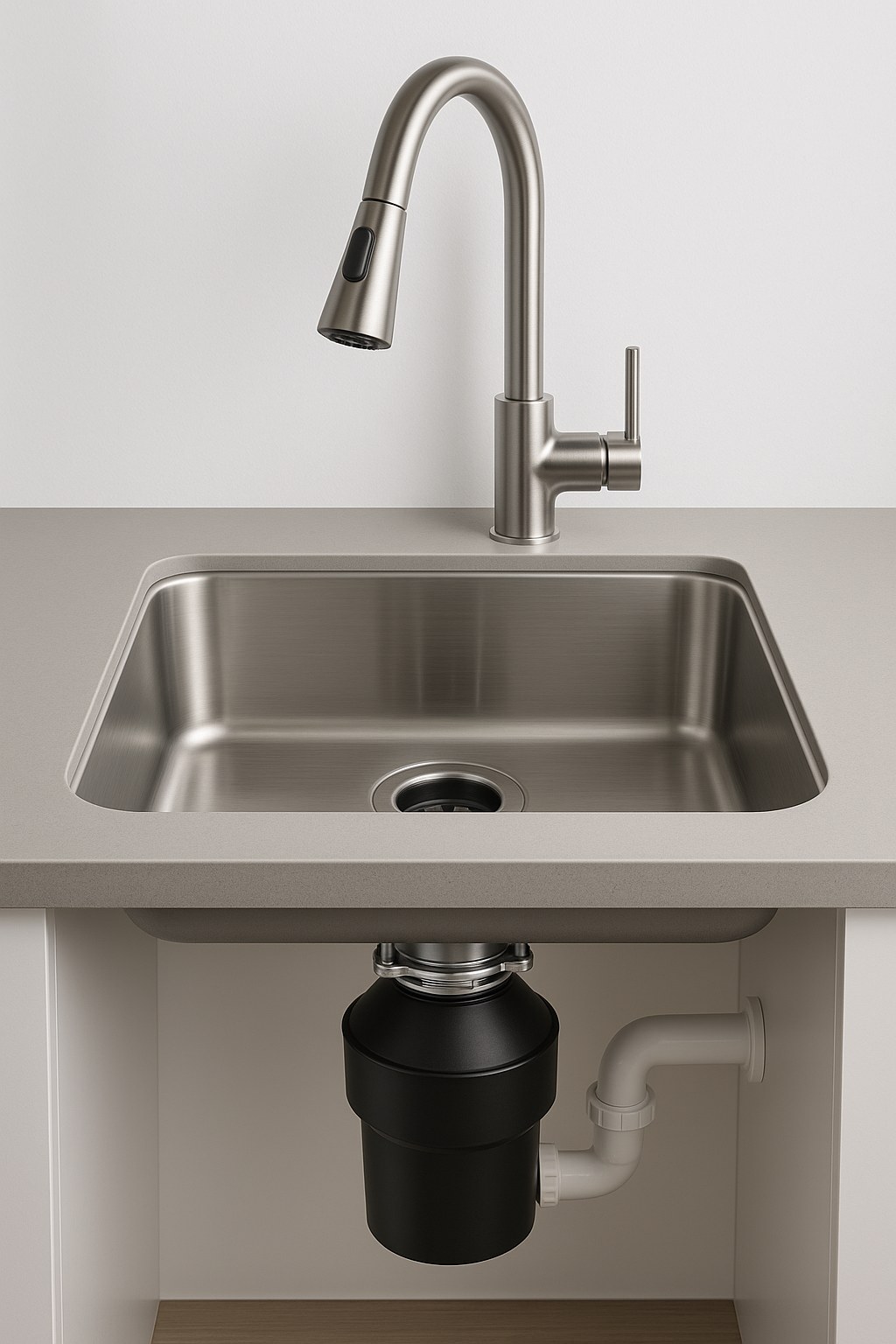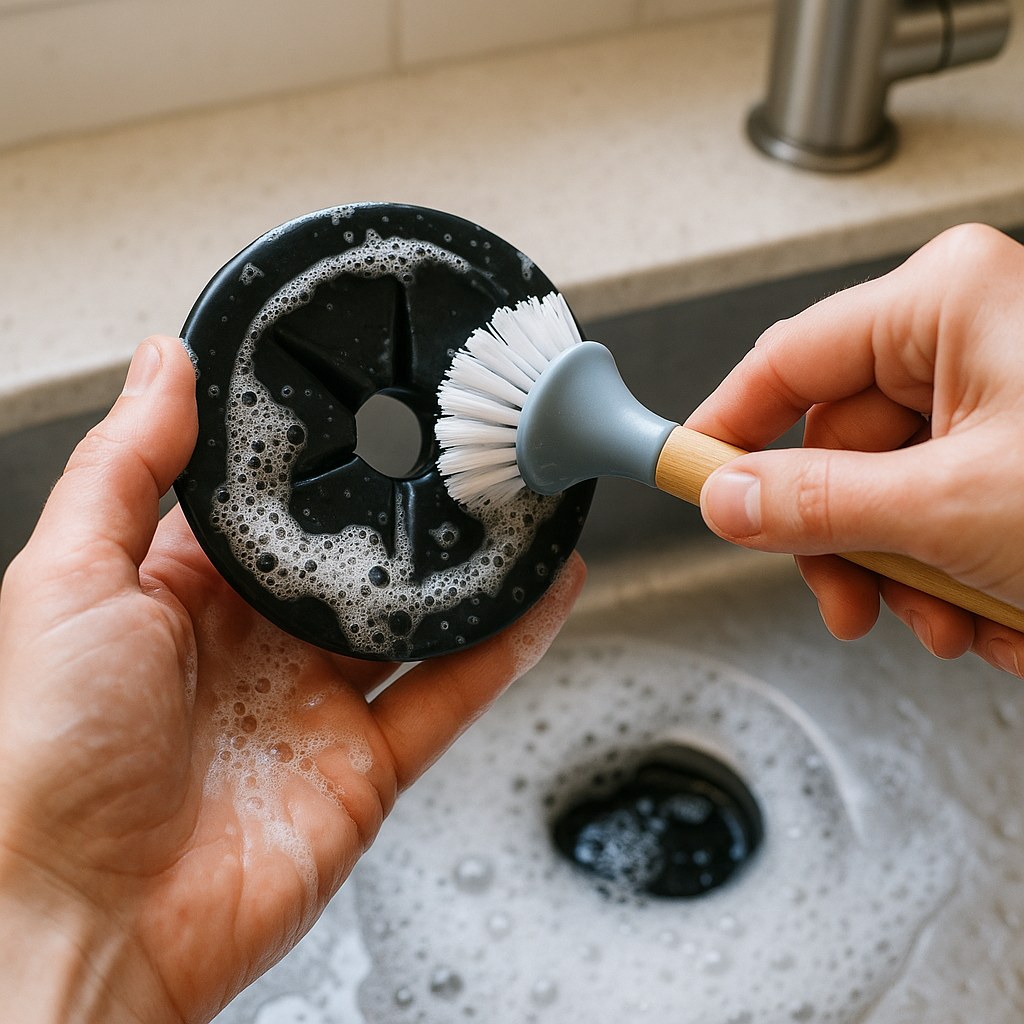How to Clean a Smelly Garbage Disposal and Banish Kitchen Odors
You walk into your kitchen, and there it is again—that unpleasant, funky smell coming from your sink. A stinky garbage disposal can ruin the atmosphere of an otherwise clean kitchen, and it’s a problem most of us have faced. That lingering odor is usually a sign that tiny food particles, grease, and bacteria have built up inside the disposal's grinding chamber and your drain pipes.
The great news is that you don't have to live with the smell, and you probably don't need to call a plumber just yet. With a few common household items and a little bit of time, you can get your garbage disposal and sink smelling fresh and clean again.
Think of me as your friendly expert on the other end of the line. I'm going to walk you through everything, step by step, from pinpointing the source of the smell to deep cleaning every nook and cranny. Let's get that kitchen smelling great again!

Why Does My Garbage Disposal Smell So Bad?
Before we roll up our sleeves, it helps to understand what’s causing that rotten drain odor. Your garbage disposal is a dark, moist environment—the perfect breeding ground for bacteria and mold. The most common culprits behind the smell include:
- Trapped Food Particles: Tiny bits of food get stuck to the grinding blades, the inner walls of the disposal, and underneath the rubber splash guard. Over time, they start to decay and release foul odors.
- Grease and Oil Buildup: Pouring grease, fats, or oils down the drain is a major no-no. They solidify and coat the inside of your disposal and pipes, acting like sticky flypaper for food scraps.
- Dirty Splash Guard: The rubber baffle at the opening of your sink drain, known as a splash guard, is a prime location for gunk and mold to build up on its underside.
- Clogged Dishwasher Hose: Many dishwashers drain through the garbage disposal. The hose connecting them can become a repository for grime and old food particles.
- Sludge in the P-Trap: The U-shaped pipe under your sink, called the P-trap, can accumulate sludge and debris, leading to persistent odors even if your disposal is clean.
Now that we know what we're up against, let's start with a little detective work.
Step 1: Pinpoint the Source of the Odor
Is the smell coming directly from the disposal, or is it wafting up from the pipes below? Figuring this out will help us target the right area.
- Run the Disposal: Turn on the cold water and run your garbage disposal for about 10-15 seconds to clear out any loose debris.
- The Drain Sniff Test: Turn off the disposal and water. Carefully lean over and smell the opening of your sink drain. Is the odor strong and concentrated right there?
- The Under-Sink Sniff Test: Now, open the cabinet under your sink. Sniff around the pipes, especially the curved P-trap and where the pipes connect.
If the smell is strongest at the sink drain opening, the problem is likely inside the disposal chamber or on the splash guard. If the odor seems to be coming from under the sink, your P-trap or pipe joints are the likely suspects.
Step 2: How to Deep Clean Your Garbage Disposal Chamber
If you've determined the smell is coming directly from the disposal, it's time for a thorough cleaning. We'll use a simple, natural, and effective method.
Safety First! Before you begin, you must disconnect the power to your garbage disposal.
- Unplug the unit from the electrical outlet under the sink.
- If you can't reach the plug or it's hardwired, turn off the corresponding circuit breaker in your home's electrical panel.
- Flip the wall switch for the disposal to confirm it has no power. It should do nothing.
Now you're ready to clean safely.
- Visual Inspection: Shine a flashlight down into the disposal. Use a pair of pliers or tongs (never your hands!) to pull out any large, visible pieces of food or foreign objects you see.
- Baking Soda and Vinegar Power: Pour about a half-cup of baking soda down into the disposal. Follow it with one cup of white vinegar. The mixture will start to fizz and bubble immediately. This chemical reaction is great for loosening caked-on grime.
- Let it Work: Let the fizzing mixture sit in the disposal for about 5-10 minutes.
- Hot Water Flush: While you wait, bring a kettle or small pot of water to a near boil. After 10 minutes, carefully pour the hot water down the drain to flush away all the gunk the baking soda and vinegar loosened.
- Restore Power and Final Rinse: Plug the disposal back in or flip the breaker on. Turn on the cold water tap and run the disposal for about 30 seconds to ensure everything is rinsed out.
This simple cleaning routine is often all it takes to eliminate bad odors. For a fresh scent, you can follow up by grinding a few lemon or orange peels.
Step 3: Clean the Overlooked Splash Guard
The black rubber splash guard in your sink drain is one of the biggest culprits of foul odors, and it's almost always overlooked. Slime and mold love to grow on its underside.

- Power Off Again: Make sure the disposal is still unplugged or the breaker is off.
- Remove the Splash Guard: If your splash guard is removable (most are), you can simply grip the edges and pull it straight up and out of the sink flange. It might be a little stubborn, but it should pop out.
- Scrub it Clean: In a small bowl, mix some warm water and dish soap. Use an old toothbrush or a scrub brush to thoroughly scrub every flap and crevice of the splash guard until it's completely clean.
- Rinse and Reinstall: Rinse it well under warm water and press it firmly back into the sink opening until it sits flush.
Step 4: Tackle the P-Trap Under the Sink
If the smell persists, or if you identified the odor as coming from under the sink, it's time to clean the P-trap. It sounds intimidating, but it's a straightforward task.

- Prepare for Water: Place a bucket or a small basin directly under the U-shaped bend of the pipe to catch any water that will spill out.
- Loosen the Nuts: You'll see two large plastic nuts, one on each end of the P-trap bend. Unscrew these by hand (turn counter-clockwise). If they are too tight, use a pair of channel-lock pliers or a pipe wrench to gently loosen them.
- Remove and Drain: Once the nuts are loose, carefully lower the trap. The water and debris inside will drain into your bucket.
- Clean the Trap: Take the P-trap to another sink or use a garden hose outside. Squirt some dish soap inside and use a flexible bottle brush or toothbrush to scrub out all the sludge and buildup.
- Rinse and Reassemble: Rinse it thoroughly and reattach it, making sure the plastic gaskets are properly seated. Hand-tighten the nuts—they should be snug, but don't over-tighten them, as you could crack the plastic.
- Check for Leaks: Run the water in the sink for a minute and check carefully around the nuts for any drips. If you see a leak, try tightening the nuts a little more.
When to Call a Plumber
You’ve deep-cleaned the disposal, scrubbed the splash guard, and even cleared out the P-trap, but the smell just won't go away. At this point, it might be time to call in a professional. A persistent odor could be a sign of a more serious issue, such as:
- A clog deep within your plumbing lines.
- A problem with your drain's venting system.
- A failing or damaged garbage disposal unit.
Hiring a professional plumber can be a smart investment to diagnose and fix the root cause correctly. According to Forbes Home, you can expect to pay a plumber between $70 and $200 per hour for a service call, plus the cost of any parts. It's a small price to pay for peace of mind and a fresh-smelling kitchen.
Keep Your Garbage Disposal Smelling Fresh
Now that your sink is odor-free, here are a few simple habits to keep it that way:
- Always use cold water when running the disposal. Hot water can melt fats, causing them to cling to your pipes.
- Run the disposal longer. Let it run for 5 seconds before adding food, and for at least 15-20 seconds after the grinding sound stops to ensure everything is flushed down the drain line.
- Grind citrus peels or ice cubes weekly. Ice helps sharpen the blades and knock off debris, while citrus peels leave a fresh, clean scent.
- Avoid problem foods: Don't put fibrous items (celery stalks, banana peels), starchy foods (potato peels, rice), or grease down your disposal.
Your Partner in Home Maintenance
Fixing a smelly garbage disposal is a satisfying DIY project that can make a huge difference in your kitchen. By following these steps, you can tackle the problem with confidence and keep your sink smelling fresh for years to come.
For more helpful guides on everyday home repairs and maintenance, download the Casa app today! Casa empowers you with the knowledge to handle projects yourself, and when you need a helping hand, we can connect you with trusted, local professionals to get the job done right. Don't let home maintenance be a mystery—let Casa be your guide.

